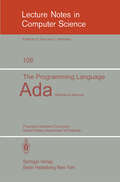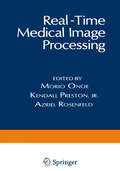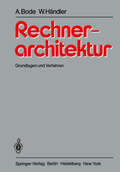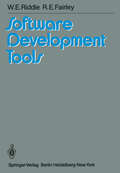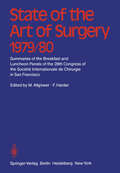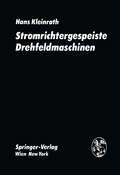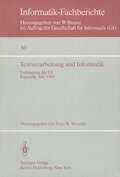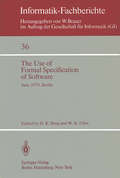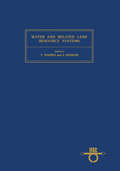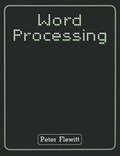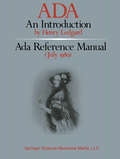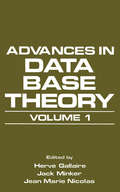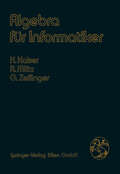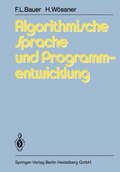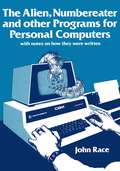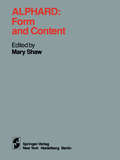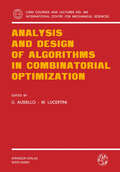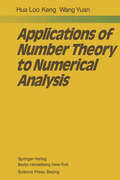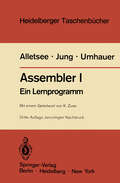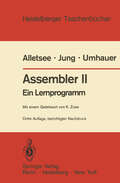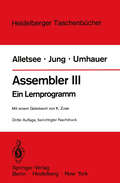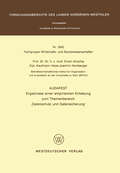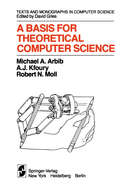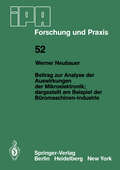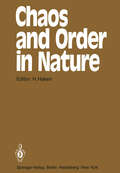- Table View
- List View
The Programming Language Ada: Reference Manual. Proposed Standard Document United States Department of Defense (Lecture Notes in Computer Science #106)
by Honeywell Cii Honeywell BullSoftware Development Tools
by W.E. Riddle R.E. FairleyThis text contains the proceedings of a workshop on software develoDment tools, held at Pingree Park, Colorado in May, 1979. The workshop, for which we were co-chair men, was primarily, but not exclusively, concerned with a variety of tools supporting pre-implementation phases of software development. The workshop brought together researchers and practitioners from industrial, governmental, and academic sectors to compare and assess current work and to set some directions for future work in this emerging technical area. The fifty participants represented research and development efforts in software tools within the United States, Canada, France, Great Britain, and Japan. (A list of participants appears at the end of the text. ) Sponsorship was provided by the National Aeronautics and Space Administration, the National Bureau of Standards, the National Science Foundation, and Digital Equipment Corporation. The conference consisted of seven formal sessions and numerous organized and impromptu discussions. Each session (except the last) included invited papers, prepared remarks by discussants, and an open discussion.
State of the Art of Surgery 1979/80: Summaries of the Breakfast and Luncheon Panels of the 28th Congress of the Société Internationale de Chiurgie in San Francisco
by Martin Allgöwer and Felix HarderInternational surgical meetings with thousands of participants speaking a dozen different languages tend to be frustrating for the individual who comes with the hope of learning about progress in his fields, but who additionally would like to be able to ex change ideas on controversial topics and to meet competent people with whom to discuss specific problems. In the "one-way" ses sions in which long papers are presented, details or specific points may be missed. Differing views often are not adequately discussed, because the meeting and its participants are pressed for time. The 44 breakfast and luncheon sessions, covering different topics of interest to the practicing surgeon, were mainly planned to overcome these classical "congress handicaps" and also to do away with the anonymous atmosphere of such a large congress. Slides and formal papers were banished from these sessions. The outcome of these very lively and pleasant discussions taking place around small well-dressed tables was unexpected by most participants. A chairman and several panel members shared their repast, caloric and intellectual, with some 10-30 congress par ticipants. The result was in each instance a lively, informative intimate discussion, very different from the anonymous atmo sphere of a large meeting. In the hope of preserving these ex changes, the chairmen were requested immediately the session finished to "distill the essence" of the 90-minute exchange into a summary captured on tape.
Textverarbeitung und Informatik: Fachtagung der GI Bayreuth, 28. – 30. Mai 1980 (Informatik-Fachberichte #30)
by P. R. WossidloThe Use of Formal Specification of Software: June 25–27, 1979, Berlin (Informatik-Fachberichte #36)
by H. K. Berg W. K. GiloiThe notion that program design is an engineering task alleviating the software crisis has been with us for about a decade. With the recognized advantages of obeying to certain software design disciplines, we are approaching the era of enforced system development standards which will ensure that end products will meet rigorous design requirements. On the one hand, advances in system architecture fUrther the application of system development standards to software and firmware design and production. On the other hand, the growth in complexity of future system architectures, in particular distri buted systems with their special problems of cooperation and parallelism, necessitate the use of rigorous specification and design techniques. In addition to hampering the design process, the lack of engineering techniques hinders research. In many cases, trial designs that are presented in abstract and informal terms do not force the de signer to face the full problem spectrum, and therefore may not sufficiently provide insight into the design process. To prepare for the forthcoming discipline and to provide a snapshot view of recent advances in software and firmware engineering, we organized in June of 1979 a seminar entitled: "The Use of Formal Specification of Software and Firmware". The seminar took place at the Heinrich-Hertz-Institute, Berlin, and attracted over 60 participants, most of them from the industry.
Water and Related Land Resource Systems: IFAC Symposium, Cleveland, Ohio, U.S.A., 28-31 May 1980
by Y. Haimes J. KindlerWater and Related Land Resource Systems covers IFAC Symposium that aims to address resource problem, as well as methodologies and procedures for respective solutions. Consists of 60 chapters, the book is organized in sessions according to the technical program of the conference. The book first tackles multiobjective planning in water and land resources, which is followed by acquisition and analysis of surface water quality data. The next part covers hierarchical water resource planning and management models, while the succeeding part is about environmental and ecological aspects of water and land resources. The fifth session discusses the impact of energy development on water and land resources. Session VI covers modeling and systems identification problems in water resources, and Session VII covers acquisition and analysis of hydrologic data. The eighth session tackles ground water and its conjunctive use with surface water, while the next session talks about sedimentation and land management. The tenth session is about multiobjective planning in water and land resources. Predicting and forecasting models in water resources is the topic of Session XI, while Session XII discusses evaluation and calibration problem in water resource modeling. The closing chapter covers water and land issues in urban areas. Professionals whose work revolves around recourse management and researchers whose work is in line with natural resource will find great information in this book that will be relevant in their trade.
ADA An Introduction: Ada Reference Manual (July 1980)
by H. LedgardIf Charles Babbage is to be regarded as the father of modern day computer technology, then surely the Countess Augusta Ada Lovelace, after whom this new language is named, must be remembered as its midwife. It was she, the daughter of England's poet Lord Byron, who translated the work of the Italian mathematician L.F. Menabrea, attaching her own scientific commentaries on the dissimilarities between the difference engine and .the analytical engine. It was Lady Lovelace, the great lady of computers, who delivered the notes and loosely organized writings of Babbage, with her own invaluable amendments, to a world not quite ready to receive them. The Ada language effort has employed hundreds, if not thousands, of minds and a healthy sum of money since its conception. Ada was fostered by the High Order Language Working Group (HOLWG), chartered by the U.S. Department of Defense in January of 1975 with the overall objective of developing a systematic approach to improved use of software by the military. One would think the Pentagon an unlikely foster parent for a new computer language. Regardless of its lineage, the question that begs asking is, of course-Why? The answer is by no means a simple one, but some brief background may help to clarify the matter. At present, the Department of Defense is the largest software consumer on earth, employing roughly 400 different computer languages and dialects. The situation, some have commented, is at best untidy.
Algebra für Informatiker
by Hans Kaiser Rainer Mlitz Gisela ZeilingerDas Kernstück des vorliegenden Buches entstand aus einer einsemestrigen Vor lesung gleichen Namens, die die Autoren seit mehreren Studienjahren an der Technischen Universität Wien betreuen und die von R.Mlitz ausgearbeitet wurde. Es erschien den Autoren notwendig bzw. zweckmäßig dieses Kernstück zu ergänzen durch lineare Algebra - die an der TU Wien getrennt vorgetragen wird - und graphentheoretische Grundbegriffe. Die von den Autoren gewonnenen Erfahrungen haben die vom üblichen Schema abweichenden didaktischen Aspekte der Darstellung geprägt, deren Grundprinzip in der nachfolgenden Einleitung erläutert wird. Das Buch richtet sich zunächst an Studierende der Informatik zum Gebrauch neben entsprechenden Vorlesungen, zum Nachschlagen und Wiederholen. Darüber hinaus soll der Anwender angesprochen werden, der in dem Werk die wichtigsten algebraischen Methoden des Informatikers dargeboten findet. Die Darstellung beschränkt sich auf den mathematischen Hintergrund und dessen direkte Anwendung. Bezüglich eventueller technischer Realis;erungen sei auf die entsprechende Literatur verwiesen. Unser besonderer Dank gilt Frau E.Wiesenbauer und Frau H.Reinauer für die sorgfältig durchgeführten Schreibarbeiten, Herrn Mag.W.Nowak für die genaue Ausführung der Graphiken, sowie dem Springer-Verlag Wien für sein Entgegenkommen und die gute Zusammenarbeit.
Alphard: Form and Content
by Mary ShawAlphard is a design for a programming system that supports the abstraction and verification techniques required by modern program'ming methodology. During the language design process, we were concerned simultaneously with problems of methodology, correctness, and efficiency. Methodological concerns are addressed through facilities for defining new, task·specific abstractions that capture complex notions in terms of their intended properties, without explicating them in terms of specific low· level implementations. Techniques for verifying certain properties of these programs address the correctness concerns. Finally, the language has been designed to permit compilation to efficient object code. Although a compiler was not implemented, the research shed light on specification issues and on programming methodology. an abstraction, specifying its behavior Alphard language constructs allow a programmer to isolate publicly while localizing knowledge about its implementation. The verification of such an abstraction consists of showing that its implementation behaves in accordance with the public specification. Given such a verification, the abstraction may be used with confidence to construct higher·level, more abstract, programs. The most common kind of abstraction in Alphard corresponds to what is now called an abstract data type. An abstract data type comprises a set of values for elements of the type and a set of operations on those values. A new language construct, the form, provides a way to encapsulate the definitions of data structures and operations in such a way that only public information could be accessed by the rest of the program.
Analysis and Design of Algorithms in Combinatorial Optimization (CISM International Centre for Mechanical Sciences #266)
by Giorgio Ausiello M. LucertiniApplications of Number Theory to Numerical Analysis
by L.-K. Hua Y. WangOwing to the developments and applications of computer science, ma thematicians began to take a serious interest in the applications of number theory to numerical analysis about twenty years ago. The progress achieved has been both important practically as well as satisfactory from the theoretical view point. It'or example, from the seventeenth century till now, a great deal of effort was made in developing methods for approximating single integrals and there were only a few works on multiple quadrature until the 1950's. But in the past twenty years, a number of new methods have been devised of which the number theoretic method is an effective one. The number theoretic method may be described as follows. We use num ber theory to construct a sequence of uniformly distributed sets in the s dimensional unit cube G , where s ~ 2. Then we use the sequence to s reduce a difficult analytic problem to an arithmetic problem which may be calculated by computer. For example, we may use the arithmetic mean of the values of integrand in a given uniformly distributed set of G to ap s proximate the definite integral over G such that the principal order of the s error term is shown to be of the best possible kind, if the integrand satis fies certain conditions.
Assembler I: Ein Lernprogramm (Heidelberger Taschenbücher #140)
by Rainer Alletsee Horst Jung Gerd F. UmhauerAls die Computer nach ihren ersten Pionierjahren etwa zwischen 1950 und 1960 in die Praxis Eingang fanden, lieB sich kaum voraussehen, welche Bedeutung einmal der organisatorische Teil einschlieBlich der Programmierung erlangen wiirde. Heute wissen wir, daB beim Compu tereinsatz die sogenannte »Software« mindestens so wichtig ist, wie die eigentliche »Hardware«. Auch ·dabei haben wir ein weites Feld, welches von strengen Theorien bis zu praxisbezogenen Arbeiten reicht. Das vorliegende Buch dient nun voll und ganz dem praktischen Einsatz der Computer. Es gibt ein gutes Bild davon, welche ungeheure Kleinar beit zu leisten ist, urn die moderne elektronische Datenverarbeitung in Gang zu setzen und in Betrieb zu halten. Das zwingt zu einer neuen Gei steshaltung und zu einer strengen Disziplin in der Verwendung von Ideen und Mitteln. Jedes Zeichen, jede Aktion, jede Anweisung muB gut durchdacht sein, und es ist kein Platz rur Schwarmerei mit unausgegore nen Ideen. So konnte sich die Datenverarbeitung auch iiber ihr eigenes Arbeitsge biet hinaus positiv auswirken und in einer in vieler Hinsicht verworrenen Zeit formend und bildend rur die ganze Gesellschaft wirken, indem ihr Geist iiber eigentliche Fachkreise hinaus wirksam wird. Hiinfeld, im August 1973 Konrad Zuse v Vorwort zur dritten Auflage In der voriiegenden, v611ig neubearbeiteten 3. Auflage dieses dreiteiligen Lernprogramms werden die heute gangigen Regeln fUr eine wohlstruktu rierte Assemblerprogrammierung erlautert und angewendet. AuBerdem wurden die bekanntgewordenen Fehler korrigiert. An dieser Stelle m6chten wir auch auf den inzwischen herausgegebenen Supplementband (Teil IV) hinweisen.
Assembler II: Ein Lernprogramm (Heidelberger Taschenbücher #141)
by Rainer Alletsee Horst Jung Gerd F. UmhauerAssembler III: Ein Lernprogramm (Heidelberger Taschenbücher #142)
by Rainer Alletsee Horst Jung Gerd F. UmhauerAudafest: Ergebnisse einer empirischen Erhebung zum Themenbereich “Datenschutz und Datensicherung” (Forschungsberichte des Landes Nordrhein-Westfalen #3042)
by Erwin GrochlaA Basis for Theoretical Computer Science (Monographs in Computer Science)
by M.A. Arbib A.J. Kfoury R.N. MollComputer science seeks to provide a scientific basis for the study of inform a tion processing, the solution of problems by algorithms, and the design and programming of computers. The last forty years have seen increasing sophistication in the science, in the microelectronics which has made machines of staggering complexity economically feasible, in the advances in programming methodology which allow immense programs to be designed with increasing speed and reduced error, and in the development of mathematical techniques to allow the rigorous specification of program, process, and machine. The present volume is one of a series, The AKM Series in Theoretical Computer Science, designed to make key mathe matical developments in computer science readily accessible to under graduate and beginning graduate students. Specifically, this volume takes readers with little or no mathematical background beyond high school algebra, and gives them a taste of a number of topics in theoretical computer science while laying the mathematical foundation for the later, more detailed, study of such topics as formal language theory, computability theory, programming language semantics, and the study of program verification and correctness. Chapter 1 introduces the basic concepts of set theory, with special emphasis on functions and relations, using a simple algorithm to provide motivation. Chapter 2 presents the notion of inductive proof and gives the reader a good grasp on one of the most important notions of computer science: the recursive definition of functions and data structures.
Beitrag zur Analyse der Auswirkungen der Mikroelektronik;Dargestellt am Beispiel der Büromaschinen-Industrie: Dargestellt am Beispiel der Büromaschinen-Industrie (IPA-IAO - Forschung und Praxis #52)
by W. NeubauerChaos and Order in Nature: Proceedings of the International Symposium on Synergetics at Schloß Elmau, Bavaria April 27 – May 2, 1981 (Springer Series in Synergetics #11)
by Hermann HakenThis book contains the invited papers of an international symposium on synergetics; which was held at Schlol3 Elmau, Bavaria, FRG, April 27 to May 1, 1981. At our previous meetings on synergetics the self-organized formation of structures in quite different disciplines stood in the foreground of our interest. More recently it has turned out that phenomena characterized by the word "chaos" appear in various disciplines, and again far-reaching analogies in the behavior of quite different systems become visible. Therefore this meeting was devoted not only to problems connected with the occurrence of ordered structures but also to most recent results obtained in the study of chaotic motion. In the strict mathematical sense we are dealing here with deterministic chaos, i. e. , irregular motion described by deter ministic equations. While in this relatively young fieJd of research computer ex periments and computer simulations predominated in the past, there now seems to be a change of trend, namely to study certain regular features of chaos by analytical metbods. I think considerable progress has been achieved in this respect quite recently. This theoretical work is paralleled by a number of very beautiful experi ments in different fields, e. g. , fluid dynamics, solid-state physics, and chemistry. For the first time at this kind of meeting we have included plasma physics, which presents a number of most fascinating problems with respect to instabilities, formation of structures, and related phenomena.
